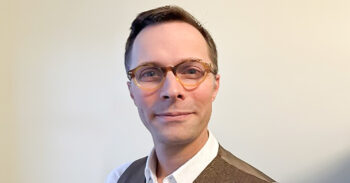Access to specialized healthcare can be challenging for Indigenous communities, but a new clinic in Kahnaw√°:ke‚ÄØ is helping bridge the gap. We spoke to clinic co-founder Romina Pace about the initiative, which is fostering trust and collaboration while addressing healthcare disparities in a culturally sensitive way.Ã˝
For many Indigenous patients, accessing specialized healthcare means leaving their community‚Äîan often daunting step rooted in historical mistrust. The General Internal Medicine Clinic, at Kateri Memorial Hospital Centre (KMHC) , launched in October 2022 through a collaboration between the ≤ª¡º—–æøÀ˘ Health Centre (MUHC) and KMHC, is changing that by bringing specialist care closer to home.Ã˝

Dr. Patrick Willemot
The idea emerged during a discussion in the General Internal Medicine Fellow Residency Committee about community rotations. Medical residents and students expressed a desire to work more closely with Indigenous communities, recognizing that many patients were reluctant to leave home for extended periods to seek specialized care unavailable nearby. Romina Pace, MDCM, and Patrick Willemot, MDCM, both Assistant Professors of Medicine at ≤ª¡º—–æøÀ˘ and members of the Division of General Internal Medicine at the MUHC, took this feedback to Rachael Eniojukan, MDCM, Director of Professional Services at KMHC, who agreed the initiative would be beneficial. With strong support from the MUHC, the clinic quickly took shape.Ã˝
‚ÄúHere in Canada, there‚Äôs a lot of mistrust with the healthcare system, and rightfully so, given the history of colonialism,‚Äù says Dr. Pace, referring to Indigenous patients. ‚ÄúWe thought bringing care to the Kahnawa‚Äôkehr√≥:non‚ÄØin a space where they feel comfortable would be beneficial.‚ÄùÃ˝
Since opening, the clinic has expanded from a half-day to two full-day clinics per month. Dr. Pace and Dr. Willemot now alternate sessions, seeing outpatients and offering specialized care for a broad range of conditions‚Äîincluding cardiology, nephrology, endocrinology, and rheumatology‚Äîso that patients can receive comprehensive treatment without leaving their community.Ã˝
But beyond just providing medical care, the clinic plays a vital role in bridging gaps within the healthcare system. ‚ÄúFamily doctors were trying their best, but sometimes they‚Äôd encounter cases outside their scope of practice,‚Äù Dr. Pace explains. Patients often avoided outside appointments due to discomfort or logistical barriers, leading to breakdowns in communication. By keeping care local, the clinic helps patients feel more comfortable seeking treatment.Ã˝
This has made a meaningful difference, especially for those managing multiple conditions. ‚ÄúMany patients struggle to see multiple specialists due to work or family responsibilities. Our clinic helps streamline care by addressing multiple issues in one visit,‚Äù Dr. Pace notes.Ã˝
Dr. Pace recalls one case that exemplifies this impact: ‚ÄúI had a young patient with a very serious medical condition who didn‚Äôt go to his appointments. His family doctor realized this and involved us in his care,‚Äù she says. ‚ÄúWe‚Äôve been following him for about a year now, and we were able to walk him through why his condition really has to be taken care of. He recently went to his specialist appointment at an outside hospital. I think we were able to make him feel more comfortable with the system again.‚ÄùÃ˝
Collaboration with local family doctors has been key to the clinic‚Äôs success. Rather than sending patients to unfamiliar institutions, Dr. Pace and Dr. Willemot work alongside family physicians to ensure continuity of care. ‚ÄúWe don‚Äôt have to refer patients outside to another institution that they might not be used to, and there‚Äôs a lot of sharing of information with the family doctor which is really helpful for continuity of care,‚Äù Dr. Pace explains.Ã˝
Bringing trainees into the clinic has been beneficial for both the trainees and the local community. ‚ÄúIt‚Äôs about understanding Indigenous patients, where they‚Äôre coming from, their knowledge, and their ways of seeing the world, so that healthcare providers know how to communicate better,‚Äù Dr. Pace says. ‚ÄúProblems with communication, the words we use, and how we express things‚Ķ. It‚Äôs really important to introduce the next generation of doctors and nurses to the community.‚ÄùÃ˝
‚ÄúExposure to healthcare professionals can also inspire community members to explore careers in healthcare. It‚Äôs not just about doctors and dentists. People can see there are also occupational therapists, nutritionists, and other professionals,‚Äù Dr. Pace explains.Ã˝
The longterm vision for the clinic involves strengthening partnerships and expanding training opportunities. ‚ÄúI think ≤ª¡º—–æøÀ˘ should continue working with KMHC to develop more training programs, making healthcare more accessible,‚Äù Dr. Pace says. ‚ÄúThis exposure might inspire community members to pursue careers in healthcare, bringing that knowledge back home and building local capacity. Increasing partnerships with the MUHC and bringing in different medical specialties would be a great step forward.‚ÄùÃ˝
For Dr. Pace, working at the clinic has been a rewarding experience. ‚ÄúI enjoy the clinic a lot, it‚Äôs been a great opportunity for me as well. Learning from the patients and family doctors and seeing great programs being developed that honor traditional methods and knowledge, I‚Äôve been lucky to participate.‚ÄùÃ˝
